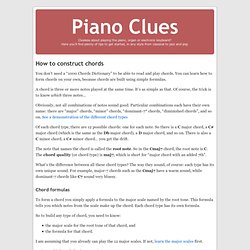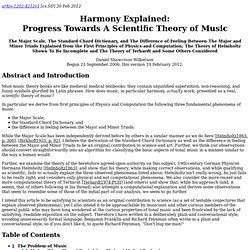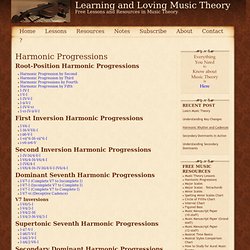

Products : Overview : Music Software. How Music Works is a comprehensive suite of multimedia tutorials which explain music in clear, simple language you can relate to. Packed with 115 topics in nine tutorials, and illustrated with 360 diagrams and 750 demonstration sounds, the tutorials start with the very basics of music and advance to topics which are valuable even for professional musicians. Whatever musical instrument or style you are interested in, these tutorials will be an essential source of information and guidance for years to come. The How Music Works tutorials are available online at www.howmusicworks.org but these tutorials are not printable and do not have the sounds.
To get the full benefit of the tutorials, the ChordWizard Music Theory software is highly recommended. Musical Scales. List of chord progressions. How to construct chords - Piano Clues: Free tips and lessons for playing piano, organ and electronic keyboard.
You don’t need a “1000 Chords Dictionary” to be able to read and play chords.

You can learn how to form chords on your own, because chords are built using simple formulas. A chord is three or more notes played at the same time. It’s as simple as that. Of course, the trick is to know which three notes… Obviously, not all combinations of notes sound good. Of each chord type, there are 12 possible chords: one for each note. The note that names the chord is called the root note.
What’s the difference between all these chord types? Chord formulas To form a chord you simply apply a formula to the major scale named by the root tone. So to build any type of chord, you need to know: the major scale for the root tone of that chord, andthe formula for that chord. I am assuming that you already can play the 12 major scales. Let’s put this knowledge into practice. The formula for major chords is: 1 – 3 – 5 We know that the scale for C major is: There are also formulas that contain the symbols b and #.
Harmony Explained: Progress Towards A Scientific Theory of Music. The Major Scale, The Standard Chord Dictionary, and The Difference of Feeling Between The Major and Minor Triads Explained from the First Principles of Physics and Computation; The Theory of Helmholtz Shown To Be Incomplete and The Theory of Terhardt and Some Others Considered Daniel Shawcross Wilkerson Begun 23 September 2006; this version 19 February 2012.

Abstract and Introduction Most music theory books are like medieval medical textbooks: they contain unjustified superstition, non-reasoning, and funny symbols glorified by Latin phrases. How does music, in particular harmony, actually work, presented as a real, scientific theory of music? In particular we derive from first principles of Physics and Computation the following three fundamental phenomena of music: the Major Scale, the Standard Chord Dictionary, and the difference in feeling between the Major and Minor Triads.
Table of Contents People push different keys on a piano; some combinations and patterns sound good; others do not. Learning and Loving Music Theory. Kelvin, You actually caught a mistake on the roman numerals!

Thanks, I’ll have to fix that. The first and last chords of the progression are not 7th chords. Somehow I inadvertently typed “I7″ on the first chord of all the major keys. (Notice that I didn’t do that for the minor keys.) In the classical tradition, for the sake of stability, the first and last chords of a circle-of-fifths progression are usually triads, not 7th chords. Harmonic Sequences Part 2 In the jazz tradition all chords usually are 7ths, in which case the progression will start and end with 7th chords.
Thanks again for your interest and input.